车辆工程毕业设计31磁流变式汽车减振器设计
一种新型汽车磁流变液减振器的设计

一种新型汽车磁流变液减振器的设计闫占辉;李晓冬;贺会超【期刊名称】《机床与液压》【年(卷),期】2014(42)17【摘要】The mechanism structure of a new type JETTA automobile Magnetorheological Fluid (MRF) absorber was presented based on MRF working principle. The magnetic path design and mechanical structure design of MRF were optimized by using FEM method,and its correctness was further verified by the absorber effect test. This kind of absorber is of simple structure,real time con-trol,and has good absorber effect.%根据磁流变减振器的工作原理提出了一种JETTA轿车新型汽车磁流变减振器的机械结构,利用FEM方法优化了磁流变减振器的磁路设计和机械结构设计,并通过减振效果实验进一步验证了磁流变减振器的磁路设计和机械结构设计的正确性。
该减振器机械结构简单,减振实时控制,具有较好的减振效果。
【总页数】4页(P119-122)【作者】闫占辉;李晓冬;贺会超【作者单位】长春工程学院科技产业处,吉林长春130012;长春工程学院机电学院,吉林长春130012;长春工程学院机电学院,吉林长春130012【正文语种】中文【中图分类】U463.33【相关文献】1.一种新型汽车馈能减振器的结构设计与特性分析 [J], 王伟华;李志成;于长淼2.一种新型汽车减振器优化设计方法研究 [J], 富丽娟;曹建国;邓定瀛;杨含离3.磁流变液减振器的结构设计与性能研究 [J], 宗全喜;林广文;廖华栋;刘旭辉4.剪切阀工作模式的磁流变液减振器参数化设计 [J], 闫占辉;谢龙华5.单筒充气式磁流变液减振器设计与仿真分析 [J], 王维成;罗一平;熊皓;王磊因版权原因,仅展示原文概要,查看原文内容请购买。
汽车减震器毕业设计
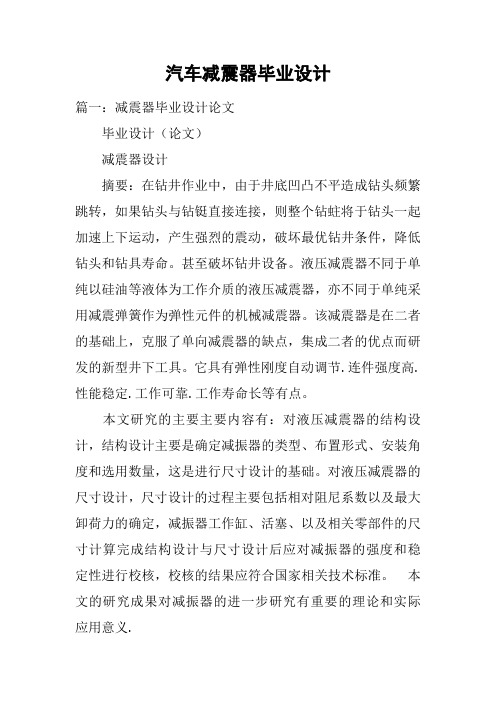
汽车减震器毕业设计篇一:减震器毕业设计论文毕业设计(论文)减震器设计摘要:在钻井作业中,由于井底凹凸不平造成钻头频繁跳转,如果钻头与钻铤直接连接,则整个钻蛀将于钻头一起加速上下运动,产生强烈的震动,破坏最优钻井条件,降低钻头和钻具寿命。
甚至破坏钻井设备。
液压减震器不同于单纯以硅油等液体为工作介质的液压减震器,亦不同于单纯采用减震弹簧作为弹性元件的机械减震器。
该减震器是在二者的基础上,克服了单向减震器的缺点,集成二者的优点而研发的新型井下工具。
它具有弹性刚度自动调节.连件强度高.性能稳定.工作可靠.工作寿命长等有点。
本文研究的主要主要内容有:对液压减震器的结构设计,结构设计主要是确定减振器的类型、布置形式、安装角度和选用数量,这是进行尺寸设计的基础。
对液压减震器的尺寸设计,尺寸设计的过程主要包括相对阻尼系数以及最大卸荷力的确定,减振器工作缸、活塞、以及相关零部件的尺寸计算完成结构设计与尺寸设计后应对减振器的强度和稳定性进行校核,校核的结果应符合国家相关技术标准。
本文的研究成果对减振器的进一步研究有重要的理论和实际应用意义.关键词:液压式;减振器;液压缸毕业设计(论文)Shock absorber designAbstract: In the drilling operation, due to the bottom hole uneven causing frequent jumps of the drill bit, drill bit and drill collars are directly connected, the entire borer will drill with accelerated up and down movement, produced a strong shock, destruction of the optimum drilling conditions, reduce drill and drill life. Even destruction of the drilling equipment. Hydraulic mechanical drill string shock absorber is different from the pure liquid silicone oil as the working medium hydraulic shock absorber, mechanical shock absorbers are also different from the simple shock absorber spring as an elastic element. The shock absorber is on the basis of the two, to overxxe the shortxxings of the one-way shock absorber, to integrate the advantages of both the research and development of new down hole tools. It has automatic adjustment of the elastic stiffness. Even pieces intensity. Stable performance and reliable work. Long working life a little.The main content of this study :The design to the structure of the gasification type shock absorber. It mainly determines the types of the shock absorber, layouts, the angle of installing and the quantity of selecting, these are the foundation of the designing of the sizes.The design to the size of the gasification type shock absorber. It includes relative damping coefficient, the determination of the biggest discharge strength, and the xxputing of the sizes of work cylinder, piston, connecting rod, valve and related spare parts.After xxpleting the structural design and the designing of the sizes, the shock absorber intensity and the stability should be checked, the results should conform to the country related technical standards.This study results have important theoretical and practical significance for further study of the shock absorber.Key words: Hydraulic ;Shock absorber; Cylinder 毕业设计(论文)目录1 绪 (1)1.1 选题的目的和意义 (1)1.2 减振器的发展历史 (1)1.3 减振器的分类 (2)1.4 液压减振器国内外发展状况和发展趋势 (3)1.5 研究的主要内容及方法 (4)2 减振器的类型和工作原理 (5)2.1减震器的类型与型 (5)2.2减震器形式的选择 (5)2.3 减振器的工作原理 (6)2.4 减振器的结构.工作原理及优点 (6)2.5 减震器的标准 (7)2.6 减震器的使用措施及注意事项 (7)3 减震器的设计 (9)3.1 减震器数据的选择 (9)3.3 芯轴的设计与强度校核 (11)3.4 上接头凸台校核 (12)3.5 螺纹的选择 (13)3.6 螺纹牙的强度校核 (13)3.7 花键的设计与选择 (16)4密封元件················································· (20)4.1 密封元件材质的设计和选用 (20)4.2 密封元件常用的材料 (20)4.3 密封盘根 (24)5 液压减震器的使用方法 (28)5.1 减震器在钻柱中的连接位置 (28)5.2 下井前的检查 (28)5.3 起钻后的检查 (28)5.4 注意事项 (28)5.5 维修与试验 (29)5.6 检查与维修 (29)5.7 组装 (29)5.8 注油················································· (30)6 结论 (31)参考文献 (32)致谢 (33)I毕业设计(论文)1 绪论1.1 选题的目的和意义减振器主要是用于减小或削弱振动对设备与人员影响的一个部件。
毕业设计 汽车减震器
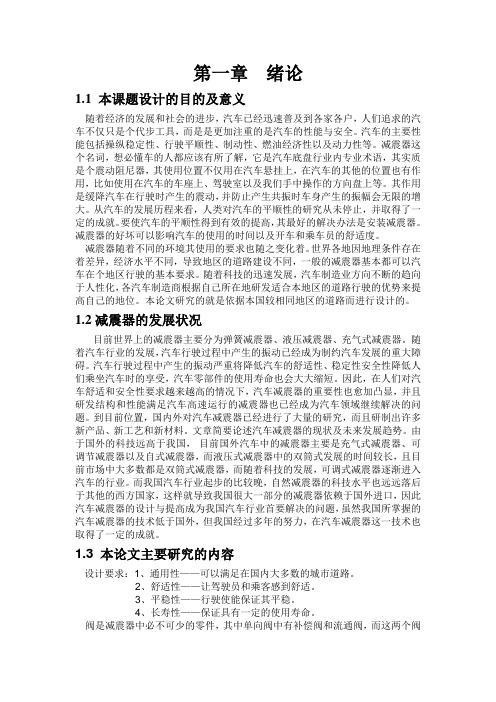
第一章绪论1.1 本课题设计的目的及意义随着经济的发展和社会的进步,汽车已经迅速普及到各家各户,人们追求的汽车不仅只是个代步工具,而是是更加注重的是汽车的性能与安全。
汽车的主要性能包括操纵稳定性、行驶平顺性、制动性、燃油经济性以及动力性等。
减震器这个名词,想必懂车的人都应该有所了解,它是汽车底盘行业内专业术语,其实质是个震动阻尼器,其使用位置不仅用在汽车悬挂上,在汽车的其他的位置也有作用,比如使用在汽车的车座上、驾驶室以及我们手中操作的方向盘上等。
其作用是缓降汽车在行驶时产生的震动,并防止产生共振时车身产生的振幅会无限的增大。
从汽车的发展历程来看,人类对汽车的平顺性的研究从未停止,并取得了一定的成就。
要使汽车的平顺性得到有效的提高,其最好的解决办法是安装减震器。
减震器的好坏可以影响汽车的使用的时间以及开车和乘车员的舒适度。
减震器随着不同的环境其使用的要求也随之变化着。
世界各地因地理条件存在着差异,经济水平不同,导致地区的道路建设不同,一般的减震器基本都可以汽车在个地区行驶的基本要求。
随着科技的迅速发展,汽车制造业方向不断的趋向于人性化,各汽车制造商根据自己所在地研发适合本地区的道路行驶的优势来提高自己的地位。
本论文研究的就是依据本国较相同地区的道路而进行设计的。
1.2减震器的发展状况目前世界上的减震器主要分为弹簧减震器、液压减震器、充气式减震器。
随着汽车行业的发展,汽车行驶过程中产生的振动已经成为制约汽车发展的重大障碍。
汽车行驶过程中产生的振动严重将降低汽车的舒适性、稳定性安全性降低人们乘坐汽车时的享受,汽车零部件的使用寿命也会大大缩短。
因此,在人们对汽车舒适和安全性要求越来越高的情况下,汽车减震器的重要性也愈加凸显,并且研发结构和性能满足汽车高速运行的减震器也已经成为汽车领域继续解决的问题。
到目前位置,国内外对汽车减震器已经进行了大量的研究,而且研制出许多新产品、新工艺和新材料。
文章简要论述汽车减震器的现状及未来发展趋势。
汽车磁流变减振器设计原理与实验测试
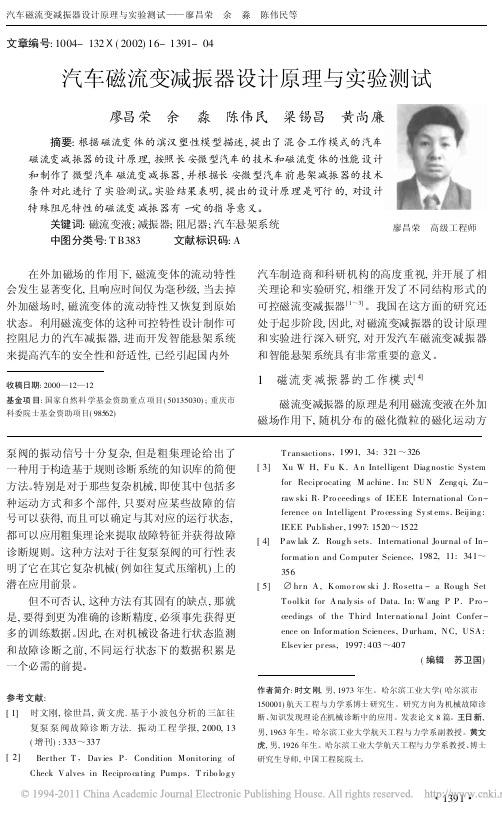
+
2 G m2
+
1 G m4
+
2 G m5
由于不考虑磁路的漏磁, 由磁路的安培环路
定理, 磁路的磁通
=
G m1
1 +
Gm3 +
NI
2 G m2
+
1 G m4
+
2 G m5
式中, N 为线圈的匝数。
( 14)
由 = B l ( R4 + R 3) 得出阻尼通道的磁感 应强度
B=
G m1
1 +
G m3
T r ansactions, 1991, 34: 321~326 [ 3] Xu W H, F u K . A n Intelligent Diag nostic System
for Recipr ocating M achine . I n: SU N Zeng qi, Zuraw ski R. P ro ceeding s of IEEE International Co nference o n Intelligent P ro cessing Sy st ems. Beijing : IEEE Publisher , 1997: 1520~1522 [ 4] P aw lak Z. Roug h sets. International Jo ur nal o f Infor matio n and Co mputer Science, 1982, 11: 341~ 35 6 [ 5] hr n A , K omo r ow ski J. Ro setta - a Ro ug h Set T o olkit for A na ly sis o f Data. In: W ang P P . P ro ceedings of the T hir d Inter natio na l Joint Confer ence on Infor matio n Sciences, D ur ham, N C, U SA : Elsev ier pr ess, 1997: 403~407
汽车减震器设计
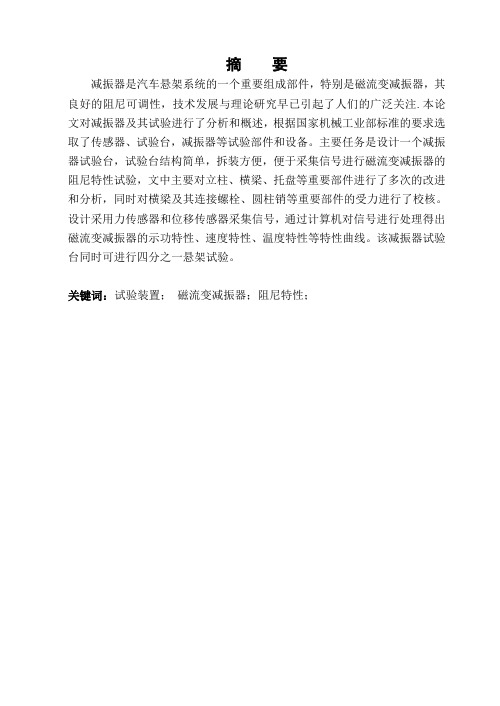
摘要减振器是汽车悬架系统的一个重要组成部件,特别是磁流变减振器,其良好的阻尼可调性,技术发展与理论研究早已引起了人们的广泛关注.本论文对减振器及其试验进行了分析和概述,根据国家机械工业部标准的要求选取了传感器、试验台,减振器等试验部件和设备。
主要任务是设计一个减振器试验台,试验台结构简单,拆装方便,便于采集信号进行磁流变减振器的阻尼特性试验,文中主要对立柱、横梁、托盘等重要部件进行了多次的改进和分析,同时对横梁及其连接螺栓、圆柱销等重要部件的受力进行了校核。
设计采用力传感器和位移传感器采集信号,通过计算机对信号进行处理得出磁流变减振器的示功特性、速度特性、温度特性等特性曲线。
该减振器试验台同时可进行四分之一悬架试验。
关键词:试验装置;磁流变减振器;阻尼特性;目录1汽车悬架及减振器1.1汽车悬架系统的概述 (1)1.2汽车悬架的分类 (1)1.3减振器的概述 (3)1.3.1被动液阻减振器技术的发展 (5)1.3.2可调阻尼减振器技术的发展 (7)1.4磁流变减振器 (10)1.4.1 磁流变液及其特征 (11)1.4.2磁流变减振器的工作原理 (12)1.4.3磁流变减振器的构造及工作示意图 (14)1.4.4磁流变阻尼器在悬架系统中的应用和发展情况 (16)2.磁流变减振器试验2.1汽车振动系统对减振器特性的要求 (19)2.2磁流变减振器试验内容和意义 (20)2.3磁流变减振器试验方法及试验系统 (23)示功试验 (23)………………………………………2 42.3.3温度特性试验 (25)2.3.4试验系统 (26)3.实验装置的设计3.1振动台等设备的选取 (27)3.1.1减振器 (27)振动台 (27)力传感器 (27)导轨的选用 (30)感器 (30)螺栓及螺钉 (31)3.2立柱的设计 (32)3.3托盘的设计 (33)3.4横梁的设计及校核 (34)3.5圆柱销的设计及校核 (37)3.6整体的装配 (38)结论 (39)致谢 (40)参考文献 (41)1汽车悬架及减振器1.1汽车悬架系统的概述悬架是车架与车桥(或车轮)之间一切传力连接装置的总称。
车辆工程专业毕业论文--智能结构与智能材料在汽车悬架减振中的应用与分析

摘要智能材料结构是一门由多学科高度交叉的新兴前沿学科,其发展潜力巨大,应用前景广阔,现已成为国际上的研究热点之一。
磁流变材料是一类新型功能材料和智能材料。
磁流变减振器是一种以新型的智能材料磁流变体作为减振器的工作液,并在减振器的活塞轴上缠绕电磁线圈,线圈产生的磁场作用于磁流变液,通过控制电磁线圈电流的大小来改变磁流变体的粘度,达到阻尼力可调要求的装置。
磁流变减振器作为优秀的半主动控制器件, 具有结构简单、体积小、能耗低、响应速度快、阻尼力连续可调、易于与计算机控制相结合等优点。
目前,磁流变减振器已被广泛运用于各种场合的振动控制,汽车磁流变减振器也已被广泛研究和应用。
本文在研究了智能材料与结构的基本定义及相关技术。
磁流变液材料的组成、磁流变液效应及其主要特征、磁流变液的主要性能的基础上,根据阻尼力的要求和机械设计基本理论,确立了磁流变减振器的基本结构参数尺寸及主要部件材料的选用,并以此为基础进行了磁路设计,得出了活塞的磁路结构。
在机械设计基本理论的指导下,计算得出磁流变减振器的结构参尺寸数,并应用AutoCAD,画出汽车磁流变减振器的装配图,分析影响磁流变减振器工作性能的主要因素。
对汽车磁流变减振器特实验台进行设计,分析磁流变减振器的相关特性。
【关键词】,智能材料;磁流变减振器;磁流变液;磁路设计;AutoCAD;;汽车半主动悬架系统试验台。
AbstractAs a newly emerging frontier inter discipline,smart materials and structures possesses a great development potential and wide application prospect,and has become one of the research focuses at home and abroad.Magneto-rheological materials are one of new type of functional and intelligent materials. Magneto-rheological damper is a damper that using a variant of magnetic flow material as the working fluid damper, and the piston axis in damper on magnetic coil winding, coils in the field of MRF, through controlling the size of the magnetic coil currents to change the viscosity of the magnetic fluid variant, damping adjustable requirements. MR damper as excellent semi-active control device, it has simple structure, small volume, low energy consumption, fast response and damping force of continuous adjustable, easy and combining computer control etc. At present, MR damper has been widely used in various occasions.Brief overview of smart structures and materials, the main research of the paper are that introduces MR fluid material composition, MR fluid effect and the main characteristics of MRF. According to the requirements of the damping force and the basic theory of mechanical design, to establish the basic structure size of the MR damper and main material selection of parts. To calculation the size of the structure, draw AutoCAD drawings of MR damper automobile assembly. Analysis on the main factors of MR affect.it makes a analysis and design to the MR Damper suspension system【Key words 】smart structures and materials;MR damper;Magneto-rheological(MR)fluids;AutoCAD;前言智能材料与结构是近年来世界上兴起并迅速发展的材料技术的一个新领域。
磁流变液减振器结构设计及仿真结果分析
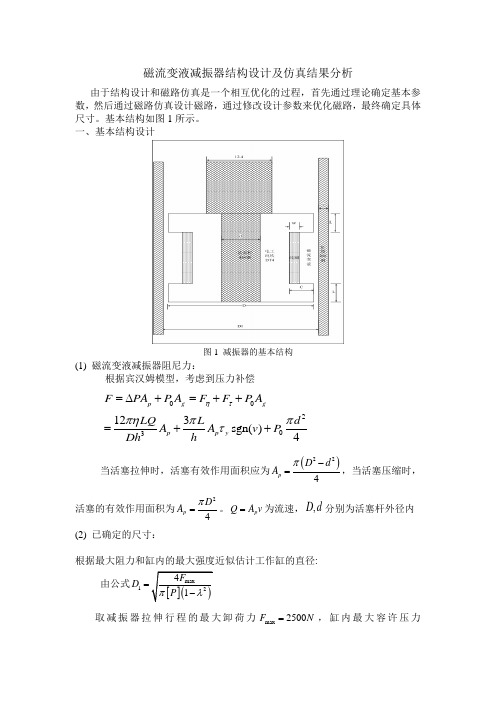
磁流变液减振器结构设计及仿真结果分析由于结构设计和磁路仿真是一个相互优化的过程,首先通过理论确定基本参数,然后通过磁路仿真设计磁路,通过修改设计参数来优化磁路,最终确定具体尺寸。
基本结构如图1所示。
一、基本结构设计图1 减振器的基本结构(1) 磁流变液减振器阻尼力:根据宾汉姆模型,考虑到压力补偿00203123sgn()4p g gp p y F PA P A F F P A LQ L d A A v P Dh h ητπηππτ=∆+=++=++ 当活塞拉伸时,活塞有效作用面积应为()224p D d A π-=,当活塞压缩时,活塞的有效作用面积为24p D A π=。
p Q A v =为流速,,D d 分别为活塞杆外径内(2) 已确定的尺寸:根据最大阻力和缸内的最大强度近似估计工作缸的直径:由公式1D = 取减振器拉伸行程的最大卸荷力max 2500F N =,缸内最大容许压力[]4P MPa =,0.3λ取,得出1=30D ,由此得d=9,若取d=12.4,反算max =2344N F ,仍然满足要求。
工作缸内径130D =,活塞头直径D=28,活塞杆直径d=12.4;工作间隙h=1(3)有效长度: 我国公路路面B, C 及路面占的比重大,建立普通减振器仿真模型,可知减振器的速度一般在O.15m/s 以下,所以根据减振器实验结果,设在O.15m/s,I=OA 时,压缩阻尼力为360N()222203336044L D d d F v p Dh πηπ-=+=零场粘度η=0.8,气体压力02p MPa =,v=0.15m/s由此得出有效长度30L =(4)线圈匝数:当工作电流为2A 时,最大可调阻尼力()22max 3360234436019844y L D d F F N h τπτ-==-=-=44.5y k P a τ=由MRF-J01磁流变液y B τ-曲线最小二乘法拟合得:140y B τ=由于活塞、缸筒等材料的磁导率要比磁流变液高出许多,相对气隙的磁阻来说很小,可以忽略。
某型汽车磁流变减振器的分析与设计的开题报告

某型汽车磁流变减振器的分析与设计的开题报告一、选题背景和意义磁流变技术是液压与电子技术的交叉应用,其具有结构简单、响应速度快、控制精度高等特点,因此在工业、军事和民用领域得到了广泛的应用。
汽车磁流变减振器是一种利用磁流变油的特性控制减振效果的装置。
在汽车行驶过程中,路面震动会通过车轮传递到汽车车身,影响到车辆的操控性能和舒适性。
传统的汽车减振器是基于液压原理设计的,其具有稳定可靠的特点,但其减振效果不够理想,特别是在高速行驶时,难以有效地减少车身的震动。
而磁流变减振器则可以根据车速和路面情况实时调节减振阻尼,从而提高汽车行驶的舒适性和操控性能。
因此,对汽车磁流变减振器进行分析与设计具有重要的意义,可以探究磁流变技术在汽车领域中的应用,同时也可以提高汽车的行驶性能和舒适性。
二、研究内容和目标本研究的内容主要包括以下方面:1. 磁流变减振器的工作原理和特点的分析与研究。
2. 磁流变油的特性以及如何控制减振效果的研究。
3. 磁流变减振器的结构设计和数学模型的建立。
4. 基于数学模型的磁流变减振器参数优化设计和实验验证。
本研究的目标是:1. 深入了解磁流变减振器的工作原理和特点,掌握磁流变技术在汽车减振器中的应用。
2. 对磁流变油的特性进行研究,并提出一种有效控制减振效果的方法。
3. 建立磁流变减振器的结构设计和数学模型,为后续的参数优化设计提供基础。
4. 通过优化设计和实验验证,得出一种性能稳定、实用性强的磁流变减振器。
三、研究方法和步骤本研究将采用以下方法和步骤:1. 研究文献资料,深入了解磁流变技术以及磁流变减振器的工作原理和应用现状。
2. 分析磁流变油的特性,以及根据路面情况和车速等因素来控制减振效果的方法。
3. 建立磁流变减振器的结构设计和数学模型,并进行仿真分析,为后续的参数优化设计提供依据。
4. 基于数学模型的磁流变减振器参数优化设计,包括控制模型、减振模型等等。
5. 进行实验验证,得出一种性能稳定、实用性强的磁流变减振器。
馈能型汽车内置永磁体磁流变减振器的设计及试验
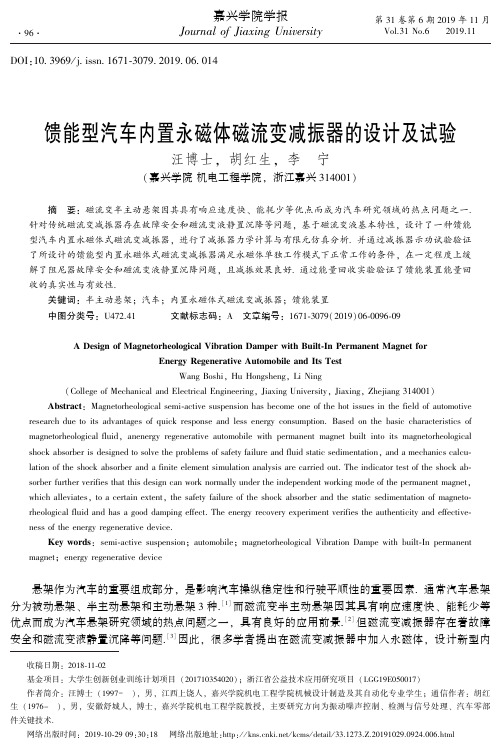
sorber further verifies that this design can work normally under the independent working mode of the permanent magnetꎬ
which alleviatesꎬ to a certain extentꎬ the safety failure of the shock absorber and the static sedimentation of magneto ̄
文献标志码: A 文章编号: 1671 ̄3079(2019)06 ̄0096 ̄09
A Design of Magnetorheological Vibration Damper with Built ̄In Permanent Magnet for
Energy Regenerative Automobile and Its Test
分为被动悬架、 半主动悬架和主动悬架 3 种. [1] 而磁流变半主动悬架因其具有响应速度快、 能耗少等
优点而成为汽车悬架研究领域的热点问题之一ꎬ 具有良好的应用前景. [2] 但磁流变减振器存在着故障
安全和磁流变液静置沉降等问题. [3] 因此ꎬ 很多学者提出在磁流变减振器中加入永磁体ꎬ 设计新型内
汪博士ꎬ 胡红生ꎬ 李 宁
Hale Waihona Puke ( 嘉兴学院 机电工程学院ꎬ 浙江嘉兴 314001)
摘 要: 磁流变半主动悬架因其具有响应速度快、 能耗少等优点而成为汽车研究领域的热点问题之一.
针对传统磁流变减振器存在故障安全和磁流变液静置沉降等问题ꎬ 基于磁流变液基本特性ꎬ 设计了一种馈能
型汽车内置永磁体式磁流变减振器ꎬ 进行了减振器力学计算与有限元仿真分析. 并通过减振器示功试验验证
汽车磁流变减振器设计原理与实验测试
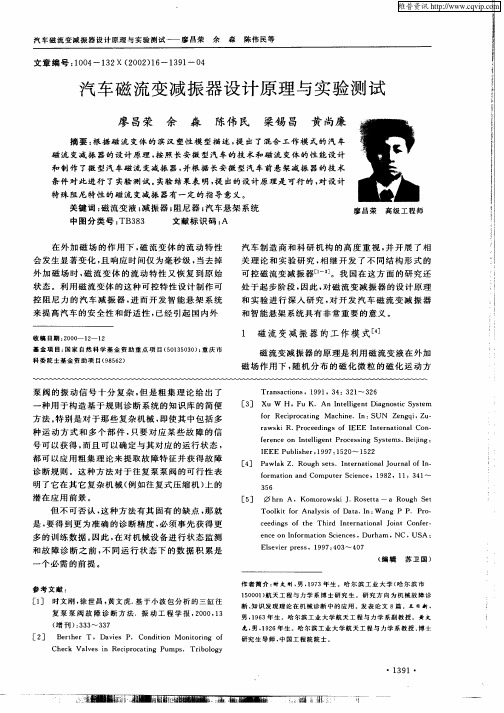
一
下 十
十
十
由于不 考 虑 磁路 的 漏 磁 , 由磁 路 的安 培 环路 定理 , 磁路 的磁通
N I
r r 尺一 () ) 一 2 ; 2n ] 一 云 一 r R I云卜 —- n ) 。 (
“ ( l 三r≤ 2 2r ≤ 三r )一 “ ( 1 Ir )一 “ (2 3r )
( 7 )
() 8
一
式 中, 为线 圈的匝数 。 Ⅳ
(一 r 尺一r( ) r 2 ; 2n ] ) 一 g意 + l r R_2 意] — z r () I n
模 式 和 剪 切 模 式 【 进 行 设 计 的 。流 动 模 式 见 图 1 ]
尼 通道 内压 力 P沿轴 向 是线 性 变化 的 , 式 ( ) 则 1 简 化 为
害 手一l 十 一 + 了一
2 磁 流 变 减 振 器 设 计
2 1 阻尼 力 的计 算 方 法 .
( 2 )
在 两 相 对 运 动 的极 板 之 间充 满 磁 流 变 体 , 加 磁 外 场 经 过极 板垂 直作 用 于 两 极 板 之 间 的 磁 流 变 体 , 使 磁 流变 体 的 流动 性 能 发 生 变 化 , 而 使 推 动 极 从
板运 动 的 活塞 所 受 阻力 发 生 变 化 , 到 外 加 磁 场 达
区域 2
“( l r≤ r )一 f r≤ 2
式中, c为常 数 。
为了简 化 , 计惯 性 力 的作 用 , 设 在 同一阻 不 并
・13 2 ・ 9
区域 3
维普资讯
汽车磁 流变减振器设 计原理 与实验 测试—— 廖 昌荣 余 淼 陈伟 民等
汽车磁流变减振器的设计及多项式模型的研究

【 摘 要】 通过对汽车磁流变减振 器的工作模式的分析, 利用 A S S电磁场模块和流体动力学模 NY 块, 建立减振器磁路有限元模型。采用序惯耦合法 , 计算得出阻尼力一 速度 关系曲线, 完成 了汽车磁流变 减振 器结构优化设计及磁路分析。 将所设计的磁流变减振器在 M S 4 减振器试验台上进行试验, T 89 测得 磁 流 变减振 器的示功 图和速度 特性 , 用试验 数据 , 行 多项式 拟合 , 确的建 立 了该 减振 器的 阻尼 力 利 进 精 模型, 与理论计算曲线比较 , 说明多项式模型能较好 的描述减振器非线性特性和滞回特性。 关键 词 : 磁流 变减振器 ; 磁路设计 ; 多项式模 型
DUAN Mi S ig S ih a n,HI n , U Ha— u J
( o e e f uo o i n rfcE g er g LT J z o 2 0 1 C ia C l g tm bl adT a i n i ei ,I , nh u 1 10 , hn ) l oA e f n n i
p e d r uo bl MR d p r h nteMR d m e ei e C s do eMT 8 9d p ret g l e f tmo i a e. e a p r s dWlt t nt S 4 a e s n t o a e m T h d g n Se e h m t i
;
— .
K y od: ge el i la e; gec i ut eg ;o nm amoe e rsMant r o g admprMant r ids nP l o il dl w oh o c ic c i y
. —
中图分 类号 :H1 , 4 3 文献标 识码 : T 6U 6. 4 A 1 月 吾 JL Ij —
单出杆汽车磁流变减振器设计及试验研究

单出杆汽车磁流变减振器设计及试验研究*摘要:磁流变减振器是实现汽车半主动控制,提高车辆行驶平顺性的重要部件。
本文在分析磁流变减振器工作模式基础上,结合汽车减振器的工作要求,分别完成了混合模式和流动模式磁流变减振器的结构设计,建立了两种模式下的数学模型并进行了相关的仿真研究,设计制作出了产品并进行了试验研究。
从工程实现和控制角度看,混合工作模式可以减少阻尼孔的堵塞并具有较大的可控倍数,其性能要明显优于流动模式减振器。
比较分析发现,二者阻尼力在低速时差异不大,但是在高速时,两种类型的减震器阻尼力差异较大。
通过试验证明,本文建立的模型、提出的设计思路和方法符合工程要求,可以为后续车辆磁流变减振器改进设计和车辆半主动控制研究提供参考和技术支持。
关键词:磁流变液 减振器 设计 试验1 引言悬架系统主要用以缓冲和吸收因路面不平而产生的激振力,衰减路面激振力所引起承载系统的振动。
传统的被动悬架,结构参数一经选定,即使经过优化,也只能在特定的车速和路面下才能达到最佳,无法随汽车运行的工况和激励的变化进行调节,不能满足使用工况的变化,减振性能的提高受到限制。
随着汽车车速的不断提高,人们对汽车行驶平顺性的要求也越来越高。
1954年GM公司Federspiel-Labrosse在悬架设计中首先提出了主动悬架的思想[1]。
主动悬架可以根据外界环境和车辆运行状态,通过控制系统产生相应的阻尼力,达到期望的平顺性和安全性。
这种悬架系统可以显著提高车辆的行驶安全性和乘座舒适性[2]。
但由于其制造成本太高,控制系统复杂,仍未发展到推广实际应用阶段。
70年代,Crobsy和Karnopp[3]等人提出了半主动悬架的概念,阻尼力可以在一定范围内实现有级或连续的变化,改善了车辆的行驶性能,其控制相对简单,成本低、耗能小、可靠性高的优异品质使得它备受青睐。
由于主动与半主动悬架可以有效提高乘坐舒适性及操控安全性,国内外对其展开了大量的研究,已经发展到多系统的集成控制研究[4、5]。
车用磁流变减振器的磁路设计

车用磁流变减振器的磁路设计
陈昆山;袁善发;刘韶庆;姚斌
【期刊名称】《拖拉机与农用运输车》
【年(卷),期】2007(34)4
【摘要】磁流变减振器磁路的设计是减振器设计中较为重要的一步,为使磁路的设计思路更加完善,对影响磁路性能的各关键问题应进行比较细致的分析。
选择合理的磁路参数和设计方法决定着减振器的设计能否满足性能要求,利用有限元分析软件ANSYS对设计的磁路结构进行了仿真,结果表明设计的磁路结构满足性能要求,磁路设计方法较为合理,通过分析仿真结果可对磁路结构进一步优化,使设计的磁路结构性能得到最大的发挥。
【总页数】3页(P79-81)
【关键词】磁流变减振器;磁路设计;磁路优化;有限元分析
【作者】陈昆山;袁善发;刘韶庆;姚斌
【作者单位】江苏大学汽车与交通工程学院
【正文语种】中文
【中图分类】U463.33
【相关文献】
1.单向阀式汽车磁流变减振器磁路设计与试验 [J], 贾永枢;周孔亢;翁茂荣;徐兴
2.汽车磁流变减振器的磁路优化设计及分析 [J], 古毅
3.基于Ansoft的磁流变减振器磁路设计与试验研究 [J], 张丽霞; 林炳钦; 李雪冰;
潘福全; 童浩; 危银涛
4.馈能型磁流变减振器磁路设计与特性研究 [J], 寇发荣; 郝帅帅; 李立博; 王睿
5.馈能型磁流变减振器磁路设计与特性研究 [J], 寇发荣; 郝帅帅; 李立博; 王睿因版权原因,仅展示原文概要,查看原文内容请购买。
基于磁流变智能弹簧的汽车主动减振悬架系统的应用技术研究31
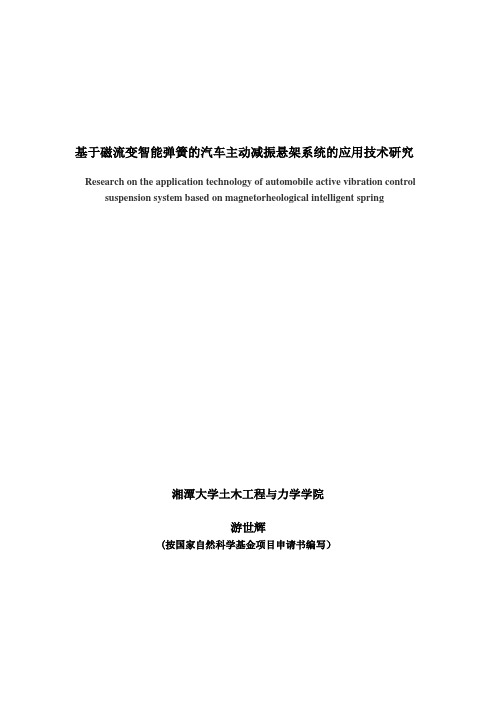
基于磁流变智能弹簧的汽车主动减振悬架系统的应用技术研究Research on the application technology of automobile active vibration control suspension system based on magnetorheological intelligent spring湘潭大学土木工程与力学学院游世辉(按国家自然科学基金项目申请书编写)摘要磁流变材料主要包括磁流变液、磁流变泡沫和磁流变弹性体等,基于磁流变技术,可以开发出磁流变阻尼器和磁流变智能弹簧等器件。
一般的主动振动控制系统应可以实时调控刚度、阻尼和高度(位移或车辆动态姿态),而目前的汽车减振悬架系统的研究主要集中在基于调整阻尼的磁流变阻尼器的半主动悬架系统。
为此,本项目希望发展一种基于磁流变技术、集成智能弹簧和阻尼器、可实时调控刚度、阻尼和高度的汽车主动减振悬架系统。
本项目主要研究:1)磁流变智能弹簧的多学科设计与优化,基于磁流变智能弹簧的汽车主动减振悬架系统的集成设计。
2)基于磁流变智能弹簧的汽车主动减振悬架系统的动力学模型及动态性能匹配设计。
3)基于磁流变智能弹簧的汽车主动减振悬架系统的移频控制理论,以及集成磁流变智能弹簧与磁流变阻尼器的汽车主动减振悬架系统的混合移频控制和调控阻尼的主动控制策略。
4)磁流变智能弹簧和汽车主动减振悬架系统的实验和应用技术。
AbstractMagnetorheological materials mainly include magnetorheological fluids, magnetorheological foams and magnetorheological elastomers, based on magnetorheological technology, and the device such as the magnetorheological damper and the magnetorheological intelligent spring can be developed. The general active vibration control system should control real-time stiffness, damping and height (displacement), but the suspension system of automobile are mainly concentrated in the semi-active suspension system adjusting damping based on magnetorheological damper. Therefore, we hope to develop an active vibration control suspension system of adjusting stiffness, damping and the height of the automobile integrated magnetorheological intelligent spring and damper. The project mainly studies:1) multidisciplinary design and optimization of the magnetorheological intelligent spring, and the integrated design of active suspension system of automobile based on magnetorheological intelligent spring. 2) the dynamic model and the matching design of the dynamic performance of active suspension system of automobile based on magnetorheological intelligent spring. 3)the frequency shift control theory of active vibration control suspension system of automobile based on magnetorheological intelligent spring, and active control strategy for hybrid frequency control and damping regulation of active suspension system of integrated magnetorheological intelligent spring and damper of automobile. 4)the experiments and application techniques of the active suspension system of automobile and the magnetorheological intelligent spring.报告正文(一)立项依据与研究内容(不超过10000字)1. 项目的立项依据(研究意义、国内外研究现状及发展动态分析,需结合科学研究发展趋势来论述科学意义; 或结合国民经济和社会发展中迫切需要解决的关键科技问题来论述其应用前景。
- 1、下载文档前请自行甄别文档内容的完整性,平台不提供额外的编辑、内容补充、找答案等附加服务。
- 2、"仅部分预览"的文档,不可在线预览部分如存在完整性等问题,可反馈申请退款(可完整预览的文档不适用该条件!)。
- 3、如文档侵犯您的权益,请联系客服反馈,我们会尽快为您处理(人工客服工作时间:9:00-18:30)。
摘要磁流变阻尼器作为优秀的半主动控制器件,已被广泛运用于各种场合的振动控制。
为改善汽车的乘坐舒适性和行驶安全性,提出一种汽车磁流变半主动悬架的控制策略。
采用磁流变减振器的车辆半主动悬架系统,由于磁流变阻尼器结构简单、能耗低、反应迅速且阻尼可调,正在成为新型车辆悬挂的发展方向,本文基于磁流变可控流体本构关系的Bingham模型,对影响车用磁流变减振器的阻尼力的各种因素进行了综合分析。
本文中介绍车用阻尼器的应用与研究现状;磁流变液的组成及磁流变效应基本原理,分析磁流变减振器的工作原理及其数学模型,结合国内外最新研究成果,综述用于汽车悬架的MR减振器的仿真模型、控制方法。
磁流变液作为流变学特性可控的一种智能材料,应用十分的广泛。
关键词:半主动悬架;磁流变效应;磁流变减振器;仿真模型;磁流变液ABSTRACTMagnetorheological damper is one of the most excellent new devices for semi-active control.A control strategy of automobile magneto-rheological semi-active suspension was proposed to improve the riding comfortableness and traveling safety of automobile.Mage- torhological dampers will be an ideal componet of semi-active vibration control in vehicle suspension system for reasons of structure,small volume,energy saving,rapid response and smooth damping.In this paper,based on Bingham model,the damping force of a MRF da- mper is analyzed.And all the factors that affect the damping force of an MRF damper are discussed.In addition the application and research status of automobile damper were intro- duce as well as the principle of magneto-rheological effect and the composition of the mag- neto-rheological fluid.Working principles and models of the automobile magneto-rheologi- acl damper was analyzed and the future focus was discussed after summaring the simulation models,control method and testing technology of automobile mageneto-rheologiacl damper of automobile suspensionAs a kind of controllable smart material,magneto-rheological fluid has gained the extensive attention.Key words: Semi-active suspension;Magneto-rheological effect;Magneto-rheological damper;Simulation model;Magneto-rheologica fluid目录摘要......................................................................................................................................... ІAbstract ................................................................................................................................ Π第1章绪论 .. (1)1.1 概述 (1)1.2 磁流变液的研究 (1)1.3 磁流变阻尼器研究现状 (2)1.4 研究的主要内容 (3)第2章磁流变阻尼器的力学模型 (5)2.1磁流变液效应及流变机理 (5)2.2 磁流变阻尼器工作模式 (6)2.3 参数计算模型 (7)2.4 本章小结 (9)第3章磁流变阻尼器的设计 (10)3.1 磁路设计的影响因素 (10)3.1.1密封件的选择 (10)3.1.2 漏磁分析 (11)3.1.3磁性材料的选择 (12)3.1.4退磁 (13)3.1.5磁流变阻尼器的动态范围 (13)3.1.6阻尼间隙的选取对阻尼器性能的影响 (13)3.1.7阻尼通道有效长度的选取对阻尼器性能的影响 (13)3.1.8磁路结构的分析 (14)3.2磁流变减振器线圈的设计 (14)3.3磁流变减振器的结构设计 (15)3.3.1结构方案的确定 (15)3.3.2磁流变减振器结构优点 (16)3.4磁流变减振器磁路的设计 (16)3.4.1有关参数的初步确定 (16)3.4.2已有参数的确定 (17)3.5磁路相关参数的计算 (19)3.5.1 磁路的计算 (19)3.6 工作缸的计算 (20)3.7 本章小结 (22)第4章磁流变减振器基于Matlab的仿真分析 (23)4.1减振器的阻尼力计算模型 (24)4.2磁流变减振器的仿真分析 (28)4.3本章小结 (29)结论 (31)参考文献 (32)致谢 (33)附录 ............................................................................................ 错误!未定义书签。
附录A外文文献原文 .................................................................... 错误!未定义书签。
附录B外文文献翻译 .................................................................... 错误!未定义书签。
第1章绪论1.1 概述汽车在行驶过程中,由于路面的不平坦,导致作用于车轮上的垂直反力、纵向反力和侧向反力起伏波动,通过悬架传递到车身,从而产生振动和冲击。
这些振动和冲击传到车架与车身时可能引起汽车机件的早期损坏,传给乘员和货物时,将使乘员感到极不舒服,货物也可能受损伤,严重影响车辆的平顺性和操纵稳定性以及车辆零部件的疲劳寿命。
为了缓解冲击,在汽车悬架中装有弹性元件,但弹性系统在冲击时产生振动。
持续的振动易使乘员感到不舒适和疲劳,因此汽车悬架中装有阻尼器。
传统被动悬架不能适应复杂的道路激励和不断变化的行驶工况,因此开发一种能够根据路面情况和车辆运行状态的变化、实时调节其特性,既能保证汽车的操纵稳定性,又能使汽车的乘坐舒适性达到最佳的状态的智能悬架系统势在必行。
近年来,半主动控制悬架系统,能够大幅度提高车辆的乘坐舒适性和操纵稳定性,非常适合用于车辆悬架系统的特点,使对它的研究有了较大发展。
磁流变阻尼器作为半主动控制悬架的执行元件,以磁流变液为介质,通过对输入电流的控制,使其对外加磁场强度发生改变,进而可在毫秒级使磁流变液的流变性能发生变化,实现流体和半固体之间的转变,从而能够提供可控阻尼力,其具有结构简单、控制方便、相应迅速、消耗功率小和输出力大等优点。
目前国内外对双筒式磁流变阻尼器研究内容较少,因此,对双筒式磁流变阻尼器的设计以十分必要。
1.2 磁流变液的研究所谓磁流变液(Magnetorheological Fluid, MFR),是一种在外加磁场的作用下起粘性和塑性等流变特性发生急剧变化的材料。
其基本特征是在外加磁场的作用下载毫秒的时间内能够快速、可逆地从自由流动的液态转变为半固体,并且呈现可控的屈服强度。
磁流变液主要由三部分组成,他们分别为软磁性颗粒、载液以及为了防止磁性颗粒沉降而添加的在总组成成分中所占比例很少的添加剂。
1)软磁性颗粒软磁性颗粒主要由铁钴合金、铁镍合金、羟基铁等常规的性能优良的颗粒,使用最多的磁性颗粒为羟基铁粉,因为它是工业化生产,产量大、价格便宜,一般成球状,直径尺寸为1-10微米,其具有如下特点:(1)高磁导率,这可以使颗粒在较小的外磁场下,便可磁化成具有较大磁能的颗粒,从而产生较大的剪切屈服强度,以满足磁流变液低能耗的性能指标;(2)低磁矫顽力,即具有良好的退磁能力,基本上不存在剩磁,这是磁流变液可以恢复零磁场状态的要求;(3)体积小、内聚力小;(4)具有高饱和磁化强度。
2)载液可用作载液的液体有硅油、矿物油、合成油、水合乙二醇等,对载液的要求是温度稳定性好、非易燃,且不会造成污染,其具有一下特征:(1)高沸点、低凝固点,这可以保证磁流变液有较高的工作温度范围,在工作过程中,使磁流变的物理、化学性能稳定;(2)高密度,缩小载液体与磁极化粒子的密度差解决磁流变液沉淀问题的最有效的方法;(3)低粘度,确保磁流变液具有零磁场粘度低的要求,使磁流变器件具有更大的调剂范围;(4)化学稳定性好;(5)具备较高的击穿磁场;(6)无毒、无异味、价格低廉。
1.3 磁流变阻尼器研究现状磁流变阻尼器因其具有结构简单、控制方便、响应迅速、消耗功率小、抗污染能力强和输出力大、阻尼力连续可调等优点,在汽车、机械、土木建筑等的振动领域得到了广泛的应用和发展。
目前,磁流变阻尼器已取得了广泛地发展和应用,其结构形式的研发也层出不穷,根据设计结构出现的时间顺序,可分为常规磁流变阻尼器、改进新型磁流变阻尼器以及全新型磁流变阻尼器。
常规磁流变阻尼器,即根据磁流变阻尼器的工作模式而设计出,单级活塞线圈内置式磁流变阻尼器。
重庆大学的廖昌荣、余淼等人是国内最早研究磁流变阻尼器的研究人员,他们根据磁流变体的Bingham模型描述,提出了混合工作模式的汽车磁流变减振器的设计原理,如图1.1活塞在工作缸内作往复直线运动,利用线圈产生的磁场来控制磁流变液在阻尼通道中的流动,对减振器的阻尼力实现控制。
